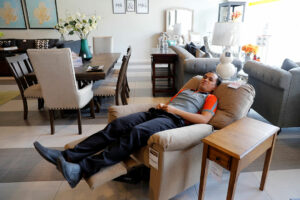By Joseph L. Garcia, Senior Reporter
THE GLOBAL coronavirus pandemic has forced Filipinos to rethink spaces and redesign certain areas of their home to make these more work-friendly.
Business establishments such as restaurants have also renovated their spaces so they can offer more immersive and multisensory experiences to customers while fostering human connection.
“The pandemic highlighted the need for adaptable living and working spaces that prioritized the health and safety of users,” Carla Mae Leonor, director of public relations at the Philippine Institute of Interior Designers, said in an interview.
“With this come solutions that ensure flexibility, incorporating movable partitions, multifunctional furniture and convertible rooms to accommodate changing needs, such as remote work and distance learning,” she added.
After being stuck at home for a long time, consumers are also seeking out experiences that can’t be replicated at home, the interior designer said.
“From immersive and multisensory dining to events and spaces that foster human connection, these brought about new hospitality spaces that provide bubble-type sanctuaries that provide resort-style amenities within a controlled space,” she said.
Some restaurants also offer dining experiences that include immersive and multi-sensory features that foster human connection, she added.
Architect Carlos Cham noted that in the first two years of the pandemic in 2020 and 2021, his company Cham-Candelaria, Inc., which specialized in restaurant and residential clients, did not have any building projects.
“All construction was put on hold for the first two years,” he said in an e-mail. “Construction only resumed, with very strict protocols, when the situation became lighter, and the vaccines started coming out.”
Philippine building activity declined by 28.5% at the height of the pandemic in 2020, but started recovering in the following year by posting growth of 31.4%, according to data from the local statistics agency.
Philippine construction had a market size of $65.2 billion (P3.7 trillion) in 2023 and it is expected to achieve an average annual growth rate of more than 7% from 2025 to 2028, according to a GlobalData report in March.
The government’s focus on infrastructure and energy development will support market expansion in real terms this year, it added.
“Fine-tuning every inch of Filipinos’ homes has become a way of cocooning to make their spaces enjoyable,” Ms. Leonor said.
They have come to adopt themes such as outdoor living, “feel-good” designs and hospitality industry-inspired interiors.
The kitchen has likewise been converted from a workspace into a living space, with more interiors attuned to hosting, she added.
‘RITUALS AND HABITS’“At-home entertaining will remain a popular choice for cautious consumers,” Ms. Leonor said.
Other changes include improvements to workspaces at home due to the work-from-home or hybrid setup spawned by the pandemic.
“Improvised workspaces are being replaced with comfortable long-term solutions,” she said.
She also cited the rise of pet-friendly buildings. “Resilient in the face of the economic downturn, the pet economy will continue to thrive,” she said, noting that new themes in interior design include making more pet-friendly spaces.
Mr. Cham said having open-air spaces for both residential and commercial projects has become a standard requirement.
“Minimalist designs are sought after not only due to the clean aesthetics but also for their practicality and function,” the architect said.
His clients also prefer more natural light and ventilation. “People really learned to appreciate this.”
Ms. Leonor cited the rise of health-friendly materials in interior spaces.
“While personal standards for health and safety can be subjective, there are guidelines that are followed by licensed interior designers,” she pointed out.
One of these is the use of smart materials that deter or destroy bacteria. “Protective materials have become central to everyday living as hygiene and protection were ramped up in light of the coronavirus pandemic.”
Consumers also no longer just protect themselves through clothing but also with the finishes that they use within their spaces, she said.
While these have mostly been used by the healthcare sector, since the pandemic, sanitizing and microbe-fighting materials are making the jump to the commercial and residential sectors.
Mr. Cham said clients who want to cut costs still use traditional concrete hollow blocks or reinforced concrete. Those who want faster construction time have turned to steel or pre-cast.
“Cost and time will always be the main factors,” he said. “It still depends on how clients would want to have it.”
Ms. Leonor said Filipinos should future-proof their spaces against future health catastrophes.
“Rethinking how we look at value also puts our minds in the right place when we design our spaces,” she said. “Hiring licensed and professional designers, for example, can ensure the best solutions are explored and the needs of the space and the users are considered in the process of designing solutions.”
Interior designers are up to date with the latest technologies and innovations and know best how to meet the needs of a client, whether they require special treatment to ensure safety, well-being and comfort, she said.
She likewise noted that antimicrobial and antiviral finishes and technology coming into the market can now be used.
People should choose suppliers with sustainability credentials to “ensure synthetic and chemical compounds do not just end in landfills or leach into wastewater post-purchase,” she added.
One can also go local, thanks to efforts to create bio-based plant- and protein-derived fibers, textiles and materials “that create healthier alternatives and promote the use of locally designed and locally made products.”
“The rituals and habits built during the pandemic have affected the preferences and priorities of consumers,” Ms. Leonor said. The past years highlighted the relationship between humans and the environment, and this shifted the appreciation of users for well-designed spaces and objects.
“The spaces we inhabit are extensions of ourselves and are therefore worth investing in,” she said. This perspective will be carried on beyond the post-pandemic recovery and will push interior designers to develop ways to make people safer and healthier and their lives more enjoyable, she added.
“Design will always continue to grow and adapt to users’ behaviors and needs,” Mr. Cham said.
